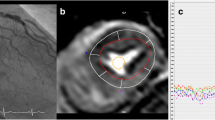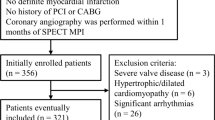Abstract
Aims
Single-photon emission computed tomography myocardial perfusion imaging [SPECT-MPI] is a functional test for coronary ischemia. We aimed to assess the additive prognostic value of coronary calcium score (CCS) to SPECT-MPI in stable patients.
Methods
This study is a retrospective analysis of 655 patients who underwent SPECT-MPI with CCS (2012 to 2017). Receiver operator characteristic (ROC) identified CCS cutoff value for all-cause mortality: CCS+ if > cutoff value and MPI+ if ≥ 5% total perfusion defect (TPD). Patients were divided into 1 MPI−/CCS−; 2 MPI+/CCS−; 3 MPI−/CCS+; 4 MPI+/CCS+ and compared. Cox proportional hazard analysis identified predictors of mortality.
Results
CCS cutoff for all-cause mortality was > 216 (C statistic 0.756, P < 0.0001). In MPI+ groups, mean TPD was similar (13.4% and 13.1% respectively) but mortality was higher in the CCS+ (12.5% vs. 4.8%, P = 0.22) as was the severe LV systolic dysfunction (8.0% vs. 0%, P = 0.095). In MPI− groups, mean TPD was similar (0.7% and 0.9% respectively) but all-cause mortality was higher in the CCS+ (10.7% vs. 1.6%, P < 0.0001) as was severe LVSD (2.9 % vs. 0.3% P = 0.016). Age, smoking, renal impairment ,and CCS > 216 were independent predictors of mortality.
Conclusions
Patients with raised CCS on SPECT-MPI have increased mortality and poor LV function despite a negative MPI.


Similar content being viewed by others
Abbreviations
- CABG:
-
Coronary artery bypass graft
- CAD:
-
Coronary artery disease
- CCS:
-
Coronary calcium score
- CTCA:
-
Computed tomography coronary angiography
- CVS:
-
Cardiovascular
- MI:
-
Myocardial infarction
- MPI:
-
Myocardial perfusion imaging
- LVSD:
-
Left ventricular systolic dysfunction
- PCI:
-
Percutaneous coronary intervention
- SPECT-MPI:
-
Single-photon emission computed tomography myocardial perfusion imaging
- TPD:
-
Total perfusion defect
References
von Ziegler F, Brendel M, Uebleis C, Helbig S, Greif M, Ruemmler J, et al. SPECT myocardial perfusion imaging as an adjunct to coronary calcium score for the detection of hemodynamically significant coronary artery stenosis. BMC Cardiovasc Disord 2012;12:116.
Greenland P, LaBree L, Azen SP, Doherty TM, Detrano RC. Coronary artery calcium score combined with Framingham score for risk prediction in asymptomatic individuals. JAMA 2004;291:210-5.
Jang JJ, Krishnaswami A, Hung YY. Predictive values of Framingham risk and coronary artery calcium scores in the detection of obstructive CAD in patients with normal SPECT. Angiology 2012;63:275-81.
Detrano R, Guerci AD, Carr JJ, Bild DE, Burke G, Folsom AR, et al. Coronary calcium as a predictor of coronary events in four racial or ethnic groups. N Engl J Med 2008;358:1336-45.
Budoff MJ, Mayrhofer T, Ferencik M, Bittner D, Lee KL, Lu MT, et al. Prognostic value of coronary artery calcium in the PROMISE study (prospective multicenter imaging study for evaluation of chest pain). Circulation 2017;136:1993-2005.
Kwok Y, Kim C, Grady D, Segal M, Redberg R. Meta-analysis of exercise testing to detect coronary artery disease in women. Am J Cardiol 1999;83:660-6.
Schwartz JG, Johnson RB, Aepfelbacher FC, Parker JA, Chen L, Azar RR, et al. Sensitivity, specificity and accuracy of stress SPECT myocardial perfusion imaging for detection of coronary artery disease in the distribution of first-order branch vessels, using an anatomical matching of angiographic and perfusion data. Nucl Med Commun 2003;24:543-9.
Iskandar A, Limone B, Parker MW, Perugini A, Kim H, Jones C, et al. Gender differences in the diagnostic accuracy of SPECT myocardial perfusion imaging: A bivariate meta-analysis. J Nucl Cardiol 2013;20:53-63.
Cantoni V, Green R, Acampa W, Zampella E, Assante R, Nappi C, et al. Diagnostic performance of myocardial perfusion imaging with conventional and CZT single-photon emission computed tomography in detecting coronary artery disease: A meta-analysis. J Nucl Cardiol 2019. https://doi.org/10.1007/s12350-019-01747-3.
De Lorenzo A, Lima RS, Siqueira-Filho AG, Pantoja MR. Prevalence and prognostic value of perfusion defects detected by stress technetium-99m sestamibi myocardial perfusion single-photon emission computed tomography in asymptomatic patients with diabetes mellitus and no known coronary artery disease. Am J Cardiol 2002;90:827-32.
Association WM. World Medical Association Declaration of Helsinki: Ethical principles for medical research involving human subjects. JAMA 2013;310:2191-4.
von Elm E, Altman DG, Egger M, Pocock SJ, Gotzsche PC, Vandenbroucke JP, et al. The strengthening the reporting of observational studies in epidemiology (STROBE) statement: Guidelines for reporting observational studies. Ann Intern Med 2007;147:573-7.
The Strengthening the Reporting of Observational Studies in Epidemiology (STROBE) Statement: Guidelines for reporting observational studies. http://www.equator-network.org/reporting-guidelines/strobe/.
Anagnostopoulos C, Harbinson M, Kelion A, Kundley K, Loong CY, Notghi A, et al. Procedure guidelines for radionuclide myocardial perfusion imaging. Nucl Med Commun 2003;24:1105-19.
Notghi A, Williams N, Smith N, Goyle S, Harding LK. Relationship between myocardial counts and patient weight: Adjusting the injected activity in myocardial perfusion scans. Nucl Med Commun 2003;24:55-9.
Shaw LJ, Berman DS, Maron DJ, Mancini GB, Hayes SW, Hartigan PM, et al. Optimal medical therapy with or without percutaneous coronary intervention to reduce ischemic burden: Results from the clinical outcomes utilizing revascularization and aggressive drug evaluation (COURAGE) trial nuclear substudy. Circulation 2008;117:1283-91.
Hachamovitch R, Hayes SW, Friedman JD, Cohen I, Berman DS. Comparison of the short-term survival benefit associated with revascularization compared with medical therapy in patients with no prior coronary artery disease undergoing stress myocardial perfusion single photon emission computed tomography. Circulation 2003;107:2900-7.
Berman DS, Abidov A, Kang X, Hayes SW, Friedman JD, Sciammarella MG, et al. Prognostic validation of a 17-segment score derived from a 20-segment score for myocardial perfusion SPECT interpretation. J Nucl Cardiol 2004;11:414-23.
Hair JF, Ringle CM, Sarstedt M. PLS-SEM: Indeed a silver bullet. J Market Theory Pract 2011;19:139-52.
Budoff MJ, Shaw LJ, Liu ST, Weinstein SR, Mosler TP, Tseng PH, et al. Long-term prognosis associated with coronary calcification: Observations from a registry of 25,253 patients. J Am Coll Cardiol 2007;49:1860-70.
Villines TC, Hulten EA, Shaw LJ, Goyal M, Dunning A, Achenbach S, et al. Prevalence and severity of coronary artery disease and adverse events among symptomatic patients with coronary artery calcification scores of zero undergoing coronary computed tomography angiography: Results from the CONFIRM (coronary CT angiography evaluation for clinical outcomes: An international multicenter) registry. J Am Coll Cardiol 2011;58:2533-40.
Chang SM, Nabi F, Xu J, Peterson LE, Achari A, Pratt CM, et al. The coronary artery calcium score and stress myocardial perfusion imaging provide independent and complementary prediction of cardiac risk. J Am Coll Cardiol 2009;54:1872-82.
Shaw LJ, Giambrone AE, Blaha MJ, Knapper JT, Berman DS, Bellam N, et al. Long-term prognosis after coronary artery calcification testing in asymptomatic patients: A cohort study. Ann Intern Med 2015;163:14-21.
Excellence NIfHaC. Chest pain of recent onset; NICE Clinical Guideline (March 2010, updated Nov 2016). 2016.
Ghadri JR, Pazhenkottil AP, Nkoulou RN, Goetti R, Buechel RR, Husmann L, et al. Very high coronary calcium score unmasks obstructive coronary artery disease in patients with normal SPECT MPI. Heart 2011;97:998-1003.
Thompson RC, McGhie AI, Moser KW, O’Keefe JH Jr, Stevens TL, House J, et al. Clinical utility of coronary calcium scoring after nonischemic myocardial perfusion imaging. J Nucl Cardiol 2005;12:392-400.
Genereux P, Madhavan MV, Mintz GS, Maehara A, Palmerini T, Lasalle L, et al. Ischemic outcomes after coronary intervention of calcified vessels in acute coronary syndromes. Pooled analysis from the HORIZONS-AMI (harmonizing outcomes with revascularization and stents in acute myocardial infarction) and ACUITY (acute catheterization and urgent intervention triage strategy) TRIALS. J Am Coll Cardiol 2014;63:1845-54.
Stone GW, Bertrand M, Colombo A, Dangas G, Farkouh ME, Feit F, et al. Acute catheterization and urgent intervention triage strategy (ACUITY) trial: Study design and rationale. Am Heart J 2004;148:764-75.
Mehran R, Brodie B, Cox DA, Grines CL, Rutherford B, Bhatt DL, et al. The harmonizing outcomes with revasculariZatiON and stents in acute myocardial infarction (HORIZONS-AMI) trial: Study design and rationale. Am Heart J 2008;156:44-56.
Nakanishi R, Li D, Blaha MJ, Whelton SP, Darabian S, Flores FR, et al. All-cause mortality by age and gender based on coronary artery calcium scores. Eur Heart J Cardiovasc Imaging 2016;17:1305-14.
Agarwal S, Morgan T, Herrington DM, Xu J, Cox AJ, Freedman BI, et al. Coronary calcium score and prediction of all-cause mortality in diabetes: The diabetes heart study. Diabetes Care 2011;34:1219-24.
Agarwal S, Cox AJ, Herrington DM, Jorgensen NW, Xu J, Freedman BI, et al. Coronary calcium score predicts cardiovascular mortality in diabetes: Diabetes heart study. Diabetes Care 2013;36:972-7.
Knapper JT, Khosa F, Blaha MJ, Lebeis TA, Kay J, Sandesara PB, et al. Coronary calcium scoring for long-term mortality prediction in patients with and without a family history of coronary disease. Heart 2016;102:204-8.
Schurgin S, Rich S, Mazzone T. Increased prevalence of significant coronary artery calcification in patients with diabetes. Diabetes Care 2001;24:335-8.
Everhart JE, Pettitt DJ, Knowler WC, Rose FA, Bennett PH. Medial arterial calcification and its association with mortality and complications of diabetes. Diabetologia 1988;31:16-23.
Sakuragi S, Ichikawa K, Yamada K, Tanimoto M, Miki T, Otsuka H, et al. An increase in the coronary calcification score is associated with an increased risk of heart failure in patients without a history of coronary artery disease. J Cardiol 2016;67:358-64.
Oei HH, Vliegenthart R, Hofman A, Oudkerk M, Witteman JC. Risk factors for coronary calcification in older subjects. The Rotterdam Coronary Calcification Study. Eur Heart J 2004;25:48-55.
Kälsch H, Lehmann N, Möhlenkamp S, Neumann T, Slomiany U, Schmermund A, et al. Association of coronary artery calcium and congestive heart failure in the general population: Results of the Heinz Nixdorf Recall study. Clin Res Cardiol 2010;99:175-82.
Green R, Cantoni V, Petretta M, Acampa W, Panico M, Buongiorno P, et al. Negative predictive value of stress myocardial perfusion imaging and coronary computed tomography angiography: A meta-analysis. J Nucl Cardiol 2018;25:1588-97.
Berman DS, Kang X, Slomka PJ, Gerlach J, de Yang L, Hayes SW, et al. Underestimation of extent of ischemia by gated SPECT myocardial perfusion imaging in patients with left main coronary artery disease. J Nucl Cardiol 2007;14:521-8.
Lima RS, Watson DD, Goode AR, Siadaty MS, Ragosta M, Beller GA, et al. Incremental value of combined perfusion and function over perfusion alone by gated SPECT myocardial perfusion imaging for detection of severe three-vessel coronary artery disease. J Am Coll Cardiol 2003;42:64-70.
Schepis T, Gaemperli O, Koepfli P, Namdar M, Valenta I, Scheffel H, et al. Added value of coronary artery calcium score as an adjunct to gated SPECT for the evaluation of coronary artery disease in an intermediate-risk population. J Nucl Med 2007;48:1424-30.
Ghadri JR, Fiechter M, Veraguth K, Gebhard C, Pazhenkottil AP, Fuchs TA, et al. Coronary calcium score as an adjunct to nuclear myocardial perfusion imaging for risk stratification before noncardiac surgery. J Nucl Med 2012;53:1081-6.
He ZX, Hedrick TD, Pratt CM, Verani MS, Aquino V, Roberts R, et al. Severity of coronary artery calcification by electron beam computed tomography predicts silent myocardial ischemia. Circulation 2000;101:244-51.
Berman DS, Wong ND, Gransar H, Miranda-Peats R, Dahlbeck J, Hayes SW, et al. Relationship between stress-induced myocardial ischemia and atherosclerosis measured by coronary calcium tomography. J Am Coll Cardiol 2004;44:923-30.
Conflict of interest
The authors have no conflicts of interest to declare.
Author information
Authors and Affiliations
Corresponding author
Additional information
Publisher's Note
Springer Nature remains neutral with regard to jurisdictional claims in published maps and institutional affiliations.
The authors of this article have provided a PowerPoint file, available for download at SpringerLink, which summarizes the contents of the paper and is free for re-use at meetings and presentations. Search for the article DOI on SpringerLink.com.
The authors have also provided an audio summary of the article, which is available to download as ESM, or to listen to via the JNC/ASNC Podcast.
Funding
None.
Electronic supplementary material
Below is the link to the electronic supplementary material.
Rights and permissions
About this article
Cite this article
Sharma, V., Mughal, L., Dimitropoulos, G. et al. The additive prognostic value of coronary calcium score (CCS) to single photon emission computed tomography myocardial perfusion imaging (SPECT-MPI)-real world data from a single center. J. Nucl. Cardiol. 28, 2086–2096 (2021). https://doi.org/10.1007/s12350-019-01965-9
Received:
Revised:
Accepted:
Published:
Issue Date:
DOI: https://doi.org/10.1007/s12350-019-01965-9




